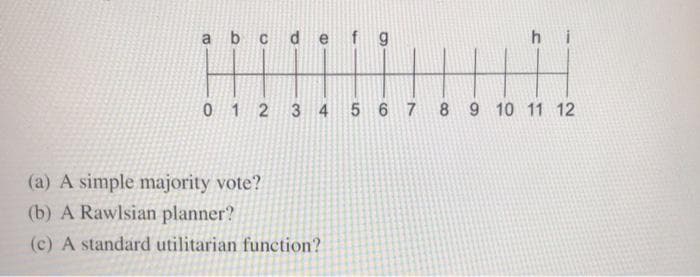2. Residents in a town are voting to decide where a new library will be built. The residents" homes are on the same street and the "map" of the town is represented below. The letters represent the location of each house. The numbers represent distance in 100 meters (in other words, house 'a' is 100 meters from house 'b' and 1200 meters from house 'i'). Each house- hold would receive a utility of 12 if the library was built in front of that house; utility decreases by 1 unit as the distance to the library increases by 100 meters. Use the distance markers (the numbers) to indicate where the library should go according to the following aggregation methods:
2. Residents in a town are voting to decide where a new library will be built. The residents" homes are on the same street and the "map" of the town is represented below. The letters represent the location of each house. The numbers represent distance in 100 meters (in other words, house 'a' is 100 meters from house 'b' and 1200 meters from house 'i'). Each house- hold would receive a utility of 12 if the library was built in front of that house; utility decreases by 1 unit as the distance to the library increases by 100 meters. Use the distance markers (the numbers) to indicate where the library should go according to the following aggregation methods:
Principles of Microeconomics
7th Edition
ISBN:9781305156050
Author:N. Gregory Mankiw
Publisher:N. Gregory Mankiw
Chapter22: Frontiers Of Microeconomics
Section: Chapter Questions
Problem 6PA
Related questions
Question

Transcribed Image Text:a bc defg
h i
0 1 2 3 4 5 6 7 8 9 10 11 12
(a) A simple majority vote?
(b) A Rawlsian planner?
(c) A standard utilitarian function?

Transcribed Image Text:2. Residents in a town are voting to decide where a new library will be built. The residents"
homes are on the same street and the "map" of the town is represented below. The letters
represent the location of each house. The numbers represent distance in 100 meters (in other
words, house 'a' is 100 meters from house 'b' and 1200 meters from house i). Each house-
hold would receive a utility of 12 if the library was built in front of that house; utility decreases
by I unit as the distance to the library increases by 100 meters.
Use the distance markers (the numbers) to indicate where the library should go according to
the following aggregation methods:
Expert Solution
This question has been solved!
Explore an expertly crafted, step-by-step solution for a thorough understanding of key concepts.
Step by step
Solved in 2 steps

Knowledge Booster
Learn more about
Need a deep-dive on the concept behind this application? Look no further. Learn more about this topic, economics and related others by exploring similar questions and additional content below.Recommended textbooks for you

Principles of Microeconomics
Economics
ISBN:
9781305156050
Author:
N. Gregory Mankiw
Publisher:
Cengage Learning

Principles of Economics, 7th Edition (MindTap Cou…
Economics
ISBN:
9781285165875
Author:
N. Gregory Mankiw
Publisher:
Cengage Learning

Principles of Microeconomics (MindTap Course List)
Economics
ISBN:
9781305971493
Author:
N. Gregory Mankiw
Publisher:
Cengage Learning

Principles of Microeconomics
Economics
ISBN:
9781305156050
Author:
N. Gregory Mankiw
Publisher:
Cengage Learning

Principles of Economics, 7th Edition (MindTap Cou…
Economics
ISBN:
9781285165875
Author:
N. Gregory Mankiw
Publisher:
Cengage Learning

Principles of Microeconomics (MindTap Course List)
Economics
ISBN:
9781305971493
Author:
N. Gregory Mankiw
Publisher:
Cengage Learning

Principles of Economics (MindTap Course List)
Economics
ISBN:
9781305585126
Author:
N. Gregory Mankiw
Publisher:
Cengage Learning

Principles of Economics 2e
Economics
ISBN:
9781947172364
Author:
Steven A. Greenlaw; David Shapiro
Publisher:
OpenStax
